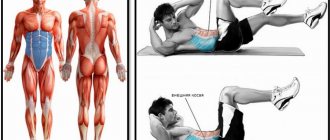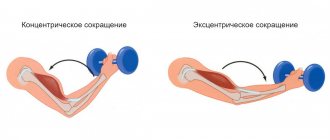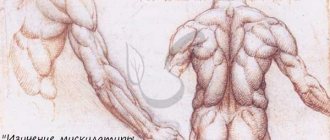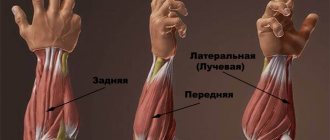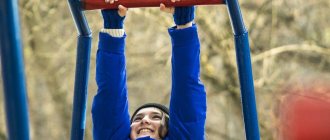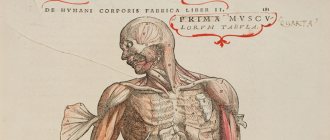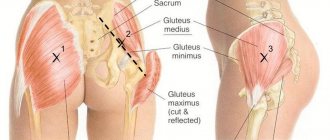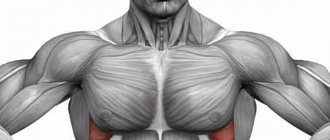Brain-muscle connection. How it works?
The relationship between the brain and muscles is responsible for the effectiveness of every exercise, every approach and repetition.
ulami.
The more effective the connection, the greater the efficiency of each exercise.
Let's imagine that your efficiency in squats is 40%. That is, the connection between the brain and muscles is not established.
This scenario has the following consequences:
- Significant reduction in efficiency . Neuromuscular connections in bodybuilding can determine your results. An athlete performs squats with a 100 kg barbell, but receives the effect of only 40 kg if the efficiency of his movements is 40%. Another athlete can squat 60kg and look much better than the first one. Because it gets the effect of all 60 kg, its efficiency is 100%;
- Changing technology . You will not feel the muscles being trained in full, as a result of which your technique will involuntarily change. Correct communication between the brain and muscles is the basis of technically correct training;
- The likelihood of injury increases . Due to improper technique and low sensitivity;
- You will feel the harm of bodybuilding , which we will discuss below.
If you have noticed athletes who lift heavy weights, do everything correctly (at first glance), but their muscles do not grow, then in such a situation, most often the culprit is a weak neuromuscular connection.
The same Jay Cutler, being a professional bodybuilder, trained with a 100 kg barbell in the bench press. His fellow members laughed at him. But he laughed at them at competitions, as he looked much more massive and more aesthetically pleasing.
How to form a connection between muscles and brain?
As we have already found out, communication is carried out through nerve impulses. That is, its quality depends on the number of signals, their intensity and frequency. And in order for these indicators to increase, you need to “think” during class. You need to think about the muscle you are training and learn to feel it. This is only possible when working with light weights. You must “hone” your technique and only then increase the load. And it’s better if you start doing this when you just come to the gym, because sooner or later, you will still need to pay attention to this if you want to see the result of your workouts.
Therefore, my advice to you is to work not only with your body, but also with your head during training!
Effective muscle training does not start with heavy weights or choice. Proper training begins with the ability to concentrate on muscle contraction to fully engage them in work - building a muscle-brain connection.
Those muscle groups that the athlete really feels in work develop and grow faster even with average working weights and moderate training. At the same time, the lack of neuromuscular connection and mechanical lifting of weight due to secondary muscles only worsens the symmetry of the body.
Is training to failure necessary?
The recommended training in bodybuilding “to failure” refers to the impossibility of performing the last repetition of an exercise when the muscle literally refuses to work due to the heavy load. In theory, this should create stress that triggers muscle growth.
However, beginners who have weak neuromuscular connections and cannot feel muscle contraction tend to use excessively heavy weights. Trying to train to failure in their case will create a risk of injury or even tissue tearing, so is strongly discouraged.
How to learn to feel your biceps?
The reason why many people don’t feel their biceps working and can’t pump them up is trivial—excessive working weight. An unbearably heavy barbell and bending the whole body only lead to pain in the joints and various posture disorders, but not to the desired muscle growth.
It begins with concentration on the exercise technique and moderate working weight. It is recommended to perform the last sets of each exercise empty-handed without weight, trying to imagine that you are lifting a large weight.
How to tense your muscles correctly?
It is important to always remember that if you mechanically lift a large amount of weight in an exercise using synergistic muscles and secondary muscle groups, you are not only increasing the risk of injury, but also significantly reducing the load on the main muscle group.
When performing both and all kinds of isolating exercises, you must mentally tense the muscles, creating and strengthening its connection with the brain. If you do not know how to feel the contractions of various muscle groups, the effectiveness of your training will not be great.
Methods for enhancing neuromuscular communication
The most important methods for developing neuromuscular communication are concentration and visualization. When performing exercises, you should imagine how the muscle tenses and relaxes, how blood circulates during contractions, and how the muscle increases in size as a result.
Concentration implies complete mental dedication to the training. If your head is constantly thinking about how to quickly finish your rep and respond to another WhatsApp message or check Instagram comments, leave your phone in the locker room.
Positive effects of pumping
The second method of strengthening the connection between the muscles and the brain is pumping - pumping and increasing the volume of the working muscle by increasing blood flow. The greater the physical volume of a muscle, the easier it is to feel its work and control this work mentally.
Both special sports nutrition and performing exercises with low weight and a high number of repetitions (for example, a combination of bench press with a barbell and push-ups) can increase blood flow in the muscles.
Development of muscle memory
The good news is that the development of neuromuscular connections correlates with the development of muscle memory - once you learn to feel your muscles and tense them with willpower, it is impossible to lose these skills even after years of no strength training.
It is precisely because of the presence of muscle memory and good neuromuscular connections that athletes are able to regain muscle volume in the shortest possible time. Let us also recall that muscle growth is associated exclusively with, and not with an increase in their number.
***
Developing the neuromuscular connection between your brain and muscles is a critical component of effective training for muscle growth. Complex and harmonious development of muscles is impossible without the ability to feel your muscles and the ability to strain them with willpower.
One of the main opportunities that the brain gives us is the ability to move. If we could not respond to the variety of information received from the outside, what would be the point of processing it? The brain controls all the muscles of the body and at every moment knows the exact position of each of them! If desired, he can be called a super-talented director...!
The brain sends an order to the right thumb to move.
Simple and fast command
The orders that the brain gives to the muscles are formed in the motor area, located in the back of the frontal lobe. In this area, all, even the smallest, muscles are reflected. So, by artificially stimulating a specific area of it, you can force the little toe to bend. Often there are only two neurons along the command path. The first is located in the motor area of the brain. Its axon passes through the spinal cord, passing to the other side of the body (the left hemisphere controls the right side of the body and vice versa), and transmits information to the so-called “motor” neuron. The signal then leaves the spinal cord and travels along the motor nerves to reach the specific muscle.
From electrical signal to movement
Between the motor neuron and the muscle there is a synapse identical to those that exist between two neurons, but which is commonly called the neuromuscular connection. When the impulse reaches the end of the motor neuron's axon, it changes from electrical to chemical. The released molecules reach muscle receptors. Just like in neurons, this contributes to the emergence of a new impulse, which causes its contraction. By contracting, the muscle attached to the bones contracts and produces movement.
Connection between neuron and muscle
Program an action
Sending a single order to a muscle to contract is easy, but making all these contractions produce a targeted effect is much more difficult! To catch a flying ball, bring a fork to your mouth or walk, the brain must plan all the necessary actions. It needs to know what the purpose of the movement is, how to position the body in space, which muscles to contract for this... This planning of the necessary actions occurs in the frontal lobe. Its neurons are in constant contact with other areas, in particular those responsible for vision and memory. The anterior part of the frontal lobe first creates an image of the required movement. From there the orders go a little back to the area that controls the muscles. And she, in turn, turns to the corresponding motor area
When the commands stop passing
It happens that for various reasons the order to contract ceases to reach the muscles. For example, if a person has suffered spinal cord damage due to an accident, the signals are interrupted at the level of damage. As a result, the muscles located below the injury site are paralyzed, while signals above it continue to pass normally. If, due to an accident, the brain, or more precisely its motor area, was damaged, the entire body may become paralyzed. And when only one hemisphere is injured, only the muscles of the opposite half of the body lose the ability to contract. This happens because the hemispheres of the brain control the opposite half of the body.
The brain controls over 650 muscles in the body!
Motor cortex
Finely tuned system
Once the motor program is running, it needs to be verified that it is correct. Environmental conditions may have changed, and the result of the movement may suddenly not be what is required. This additional control is handled by the cerebellum. This part of the brain, located at its base, receives all the information sent from the motor area and coming from the sensory receptors (vision, touch...). Thus, he knows all the motor intentions of the brain and all the results of the instructions it gives to the body. By comparing these two streams of information, the cerebellum can send corrective signals to the motor area.
Repetition is the mother of learning
When someone plays ping pong for the first time, they play it clumsily and rarely hit the target. But, thanks to many hours of training, professional athletes are able to send the ball with amazing speed exactly to the desired area of the table! This difference in skill is based on a single principle: the more often certain connections between neurons are used, the faster nerve impulses travel. Like others, movement skills arise based on this principle: the more often a movement is repeated, the faster and more accurate it becomes. This is one of the secrets of champions...
Exercise makes neurons fire
Walking is an innate reflex of a newborn
If you lift a newborn so that his legs touch a flat surface, he begins to rearrange them, as when walking. However, his brain is not yet developed enough to control such a motor program. The movement of a baby's legs is a reflex that does not require brain intervention. These movements appear to be controlled by specialized neural circuits located in the spinal cord. They are called a “walk generator.” Only by 3-4 months do leg movements become fully conscious.
Imaginary movement excites the same neurons as real movement
After a long break between workouts, muscles atrophy without load. However, if you have previously been active in sports, physical fitness returns relatively quickly. It takes you less time to increase muscle size, strength and endurance than beginners due to the mechanism of muscle memory.
This phenomenon is explained by the work of the nervous system, namely increased excitability of motor neurons and the emergence of new synapses, which leads to an improvement in neuromuscular coupling. In the motor cortex of a trained athlete who has started training after a break, accelerated growth of new vessels and improved nutrition of motor areas occurs, and neurotrophic factors are secreted.
For example, if you are trying to straighten your knees first in a squat, you can work on this mistake by focusing on driving your hips back, perhaps to a specific target, like a rack (as in a rack squat), and consciously telling yourself to “sit back” on each rep. . If you need to correct the mistake of placing weight on your heels when deadlifting, try curling your big toes or think about pressing your heels into the floor.
The more advanced you become with each exercise, the more you will be able to trust your senses!
With love, BodyLab Team
My respect, friends and fighting friends! Today we are waiting for an article that is by no means ordinary, and it will be devoted to such a phenomenon as the brain-muscle connection. I am sure that each of you has heard about it at least once from more experienced fellow gym members or personal trainers, but what it is in practice and how to feel it is a completely different question, to which it is usually difficult to hear a clear answer. So in this article we will learn everything about this mental connection, talk about how it works, how to pump it up and what means to use to strengthen it.
In general, everything will be very tasty, so let's start broadcasting.
Neuromuscular connection in bodybuilding
Wear and tear of the nervous system is the key harm of bodybuilding. It’s not customary to talk about this, but it is the central nervous system that is most often the most vulnerable point in iron sports.
There are several training factors that wear out the nervous system:
- Overtraining . Everything is clear here, it must be avoided;
- Poor neuromuscular connection . A weak impulse from the muscles to the brain and back itself loads the nervous system;
- Large weights . Due to poor communication, you have to take heavy weights. And this is a huge burden on the nervous system.
The formation of neuromuscular connections in bodybuilding is important not only for results, but also from the point of view of maintaining health.
The mechanism of muscle action
Human muscles use the principle of contraction when working. To put it simply, when muscles contract, they lengthen, and when they move, they shorten. It should be noted. That muscles can be in one of three states:
- Relaxed;
- Stretched;
- Abbreviated.
From a purely technical point of view, when contracting, muscles should shorten, but this always implies movement. Many athletes do not want to understand the intricacies of the anatomical structure of their body and do not know that skeletal muscles have several options for contraction.
The simplest types of muscle contraction are isometric and isotonic. In the first case, when performing movements, the length of the muscle does not change, but in the second case this happens. Thus, isotonic contraction can be divided into concentric and eccentric. During a concentric contraction, the muscles become shorter and compressed. If the contraction is eccentric, the muscle lengthens.
Development of neuromuscular communication
The development of communication between the brain and muscles is based on:
- Preparatory stage . At this stage, we train with weights that are 1.5-3 times less than usual. Let's take the same squat of 100 kg. We reduce the weight to 50, perform the exercise smoothly, and monitor the technique. Learning the perfect technique. The preparatory period lasts from 2 to 4 months. But in general, the longer the better. And we are progressing very slowly. In fact, these 2-4 months you need to stagnate at a weight of 50 to 55 kg. And then gradually add more. 2.5 kg every 1-2 weeks, for example;
- Technique development . Additionally, we train the technique of basic exercises outside the gym. You can practice squats, imitate bench presses or pull-ups as morning exercises before bed. The neuromuscular connection in bodybuilding is formed only through frequent repetition of the same movements with the correct technique;
- Technically correct exercises . Under no circumstances should you break your equipment for the sake of faster progress.
We reduce the weight in all exercises and begin preparing for the future jerk. It is permissible to increase the frequency of visits to the gym. If you trained 2-3 times a week, now you can increase the number of workouts to 4-5 in 7 days.
Since the load will be reduced by 2 times, an increase in visits to our favorite rocking chair will only play into our hands. But you can’t completely forget about rest.
Well, now let's talk about personal things.
What is the neuromuscular (mental) connection?
Have you ever wondered what causes muscles to contract? How do we control our limbs? And in general, how does it work? After all, all top athletes are well aware of the neuromuscular (mental) connection, because They have it very well developed, thanks to years of training. In this article we will try to answer all these questions.
What is the neuromuscular (mental) brain-muscle connection?
Neuromuscular communication is the connection between your brain and muscles, which is carried out by the NR (nervous system), through which these signals pass. In simple terms, this is the feeling of muscle contraction, how well you feel a certain working muscle or muscle group in an exercise. Let's say you do regular push-ups and work your pecs, but the next day it's not your pecs that hurt, but your triceps. This suggests that you have poor neuromuscular communication and have poor feel for the muscle group being worked, or you simply performed the exercise incorrectly from a technical point of view. That is, this skill allows you to master the process (contraction) of a certain muscle or muscle group with the help of the brain (the power of thought). Do you strengthen your grip, do you push the projectile at a certain speed, do you strain or contract your muscles without additional. weights or simply raising or bending your arm - all this (all these processes) is carried out due to neuromuscular connections.
What does the neuromuscular connection between the brain and muscles give us?
The connection between muscles and brain is a very useful skill because... this ability allows you to feel and control the tension in your muscles. Simply put, the stronger the brain is connected to the muscles, the better we will be able to feel them and, accordingly, control them. Pay attention to top bodybuilders or just look at a photo of Schwarzenegger, his muscles are the fruit of well-established work between the brain and muscles. The volume of his arms or chest suggests that he clearly felt all his muscles well. He sweated in the gym for years, established a mental connection with the help of this, ate well, rested, and all this together gave a colossal result. Therefore, if you want to make your body strong, beautiful and functional, you must establish neuromuscular connections and feel your muscles.
How does the neuromuscular/mental connection (mind-muscle) work?
It's all about impulses. When we want to do any action or allow a contraction, our brain at this time sends signals to our muscles. The decisive factor here is the impulses, or rather their quality & quantity, i.e. the more nerve impulses there are, the higher the strength of each impulse + the frequency with which these impulses are transmitted from the brain to the muscles, the more resistance you create or the amount of force you work with. The better this connection is established, the better you will be able to control the compressive force, and your brain will also learn to conserve energy, directing the flow of force only in the right direction, while preserving the supporting muscles. Those. Before performing any action, the brain first evaluates which muscles need to be used the most and least, it also needs to take into account the applied force, the force of compression and the sequence of muscle contraction. A certain section (zone) of the brain, which is drawn in blue, is responsible for all this (see figure below):
The figure above shows the area of the brain (motor/motor area) that is responsible for the very signals (nerve impulses) that coordinate the work of all motor functions and movements. Those. Before you perform any action, the premotor zone (responsible for orientation, control of the head and eyes) is first turned on, and after it the motor zone is connected, with the help of which the process itself is carried out. Also, depending on the complexity of the action being performed, other areas of the brain are also involved in the work (for example, playing the guitar or drums), but this is another, separate topic.
How to establish a mental connection between the brain and muscles?
The first thing that is necessary in order to establish a mental/neuromuscular connection is to perform any exercise correctly from a technical point of view. The second, and perhaps most important, is the weight. It is important to work with relatively light weights for a long time. For what? All this is done so that you can fully concentrate on the very muscle groups that are actively involved and contracted in the exercise. You can also, outside the gym or just before going to bed, perform imitation exercises without load (which will create an imitation of the movement when performing the exercise); during these movements it is important to fully concentrate on the working muscle group that is involved in this exercise. It is recommended to perform these complexes on an ongoing basis, in the evening or before bed. Because Scientists have long found out that this is the time that is best suited for the brain to create and establish new connections for accelerated work and increased productivity. Thanks to such simple simulated workouts, you will learn to feel your muscles and control them well. Those. if you tense some muscles without load (for example, pectoral muscles), this will indicate good and well-established functioning of the neuromuscular connection.
These skills will allow you to increase the impact of your training, because only target muscle groups (bundles) will be loaded, which will allow you to correctly distribute the load during training and increase efficiency.
The brain-muscle connection in bodybuilding. Personal experience
The author of this material was able to personally experience how important the neuromuscular connection is in bodybuilding. When I first got into the gym, my first training session coincided with the beginning of the training journey of one guy, who later performed well at club competitions.
We started with the same results. Both of them bench pressed 30 kg on a horizontal bench and were terribly unhappy with it.
After 2 months, I had already achieved a result of 50 kg, and also improved my performance in other exercises. He was stuck at the level of 30-35 kg, and did not progress in other exercises.
This guy was complaining to me about his slow progress...
It is important to mention one nuance: he worked with a coach, and I selected the load on my own.
Then I was glad that I decided to do without coaching help, but a year later my opinion changed to the diametrically opposite.
A year later, he was bench-pressing 100 kg and confidently moving forward in every workout. I reached a plateau and was stuck at 80 kg.
He looked, taking into account the basically small difference of 20 kg of bench press, much better.
The thing is that the coach helped him form the correct brain-muscle connection, but for me its necessity and, in general, existence were not obvious.
In the end, I had to disassemble the barbell, drop to 40 kg, and do it all over again. While my friend was preparing for competitions and breaking new personal records.
This is how important neuromuscular communication is in bodybuilding.
Have you worked on building the brain-muscle connection? Are you planning to do this? Share your opinion in the comments!
What is the mental brain-muscle connection?
Beginners are prone to technical errors when performing exercises. Over time they are corrected. You can also now find a lot of information about the correct execution of exercises. In this regard, the issue of the brain-muscle connection in bodybuilding becomes more relevant.
Many athletes do not pay due attention to this issue, and for this reason it is worthwhile to dwell a little more on the connection mechanism. Surely many have seen and even experienced it when, when performing exercises, the body behaves asynchronously, the hands shake, and the barbell lowers and rises convulsively. All this is typical for beginners and everyone goes through it.
In most cases, the reason for this is not the large working weight of the sports equipment, but rather the weak connection between the brain and muscles. The channel transmitting the nerve impulse is very weak and even if a person knows how to perform the movement correctly, it will be very difficult to do so.
How the brain-muscle connection works
If you look closely at experienced athletes, you will notice their ability to deplete muscle resources even with minimal loads. At the same time, novice athletes can work with tons of iron and not achieve the desired effect. The reason for this phenomenon lies in the powerful mental mind-muscle connection in bodybuilding.
This connection can be represented as a channel connecting the brain and muscles. The more stable this connection is, the more harmoniously the muscles work. In this case, communication is carried out in two directions. It is the signal sent by the nerves that will determine the amount of force created by the muscle. When performing any exercise, the brain needs to determine which muscles should be used and with what effort.
The spinal cord is also involved in establishing a communication channel between the brain and muscles. It should be recalled that it consists of gray and white matter. The white matter consists of nerve fibers, and the gray matter consists of interneurons and motor neurons. The signal created by the brain travels along the nerve fibers of the white matter and activates the necessary motor neurons located in the gray matter.
Thus, it can be stated that the number of fibers and motor units is of decisive importance during muscle contraction. The stronger the signal transmission channel, the more actively the muscles work, and, consequently, the athlete progresses.
How to pump correctly - neuromuscular connection
Why do muscles feel different or why is the mental connection between the brain and muscle important? There are many parts of the brain that are responsible for performing different functions. The part that is primarily responsible for muscle action during lifting is called the motor center.
When you train, of course, it is this center that mainly works, but this does not mean that the others have switched off. In most cases, multiple parts of the brain are active at once, which means your head is full of tasks - even during strength training.
Human muscles can be in three states:
- relaxed (relax);
- stretched;
- contraction.
There are two main types of muscle contractions - isometric
and
isotonic
. With isometric, the length of the muscle during the movement remains constant (does not change). With isotonic, a change in muscle length occurs when working against external forces. There are also two types of isotonic contractions - concentric and eccentric. With concentric, the muscles shorten and compress, for example when demonstrating biceps. When eccentric, the muscles lengthen through the process of contraction.
The brain is responsible for contractions and muscle function in general through neuromuscular connections.
. The impulse from the brain is transmitted to the so-called motor neuron, which are located in the spinal cord. From the motor neuron to the muscle fiber, the impulse moves along the axon - a long nerve, the end of which branches and each hair of which is responsible for a separate muscle fiber.
Muscles are made up of bundles of muscle fibers. So one motor neuron is responsible for several fibers - all this together is called a motor unit. And for the entire muscle there is a set of motor neurons. Motor neurons can innervate any number of muscle fibers, but each fiber is innervated by only one motor neuron. When the motor neurons fire, the muscle fibers contract.
And this is where the fun begins. Different motor neurons respond to impulses from the brain of different frequencies. Our body tries to complete any work with as little cost as possible.
. The higher the frequency of the impulse sent from the brain to a set of motor neurons, the greater the number of fibers we can control or use for work.
So through training or the development of neuromuscular communication
called the adaptation of our brain to the control of motor neurons. The better this connection, the more muscle fibers we can force to work, and therefore train.
When you just start exercising, the neuromuscular connection between the brain and the muscles is still weak, so the “orders” that the brain gives to the muscles are poorly executed. That’s why the knees tremble, the elbows wander, and the leg doesn’t lift as high as we would like. With experience, the neuromuscular connection becomes much better, which is especially evident in the first few months.
Usually, beginners make great progress in strength indicators, although the muscles do not seem to grow. This is because progress occurred due to an increase in efficiency, the neuromuscular connection became significantly better, which led to an increase in strength indicators. In the first months, beginners usually get the impression that they are just super pumped up (this is not true
